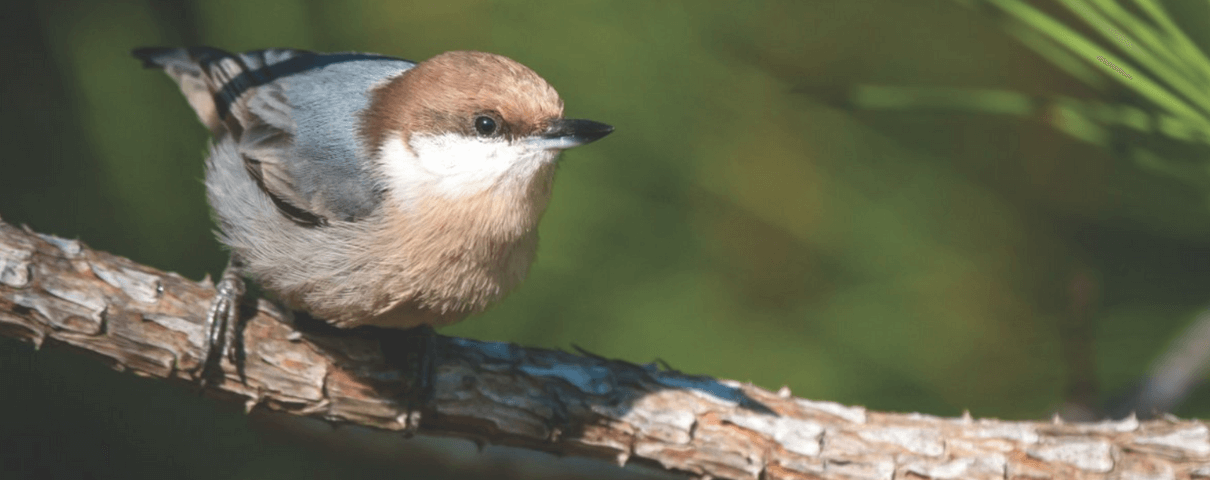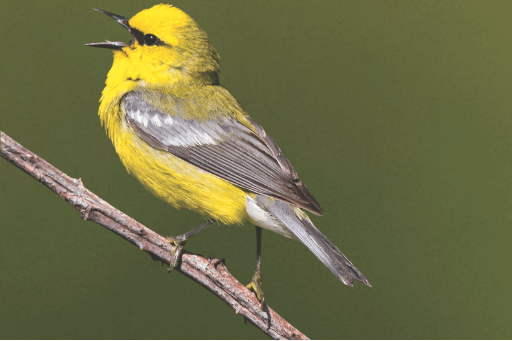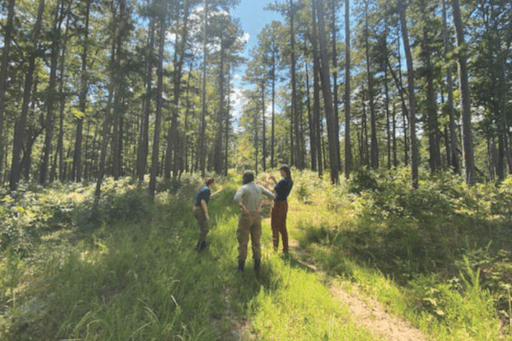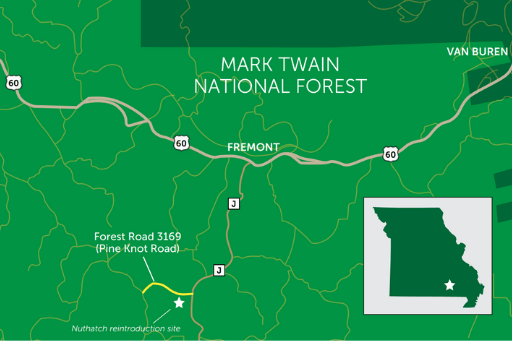ABC Birding: Current River Hills, Missouri
In “ABC Birding,” we take you to a birding site benefiting from ABC and partners' conservation efforts. Before traveling, please consider your health, CDC guidelines, and local restrictions.
Lay of the Land
This is the chance to visit a restored open woodland system in Mark Twain National Forest that is dominated or co-dominated by Shortleaf Pine, a species and ecosystem once widespread in the Missouri Ozarks. The pines, some very large and long-lived, are widely spaced, with an understory of shrubs, native grasses, and wildflowers.
In the past, this park-like spacing of trees and diverse understory of plantlife resulted from frequent fires, set both by lightning and by Native Americans, who used fire to maintain areas for hunting and grazing.
After European colonization, the Shortleaf Pine woodlands were largely decimated by widespread logging, free-range grazing, and subsequent suppression of the fires critical to their persistence. They re-grew mostly as closed-canopy oak forests, which now cover large areas of this national forest. Some species closely tied to the open-pine structure, including the Red-cockaded Woodpecker and Brown-headed Nuthatch, disappeared from the region.

Focal Birds
The star of the show is the repatriated Brown-headed Nuthatch, a species that disappeared from Missouri in the early 20th century and was reintroduced as a result of the landscape-scale habitat restoration efforts. All told, 102 birds were translocated from the Ouachita Mountains in Arkansas and released in the Mark Twain National Forest in 2020 and 2021, the result of a collaborative effort between various partners, including the U.S. Forest Service, the Missouri Department of Conservation, the Central Hardwoods Joint Venture (CHJV) (of which ABC is a part), and Tall Timbers Research Station in Florida.
Listen for the nuthatch's unique call, which sounds like a squeaky dog toy and is most easily detected around March, just prior to breeding season. It was recently confirmed that the birds are indeed nesting in the restored habitat.

Other species of conservation concern found in the same habitat and nearby include the Prairie Warbler, Blue-winged Warbler, Kentucky Warbler, White-eyed Vireo, and other shrub-nesting species, along with the Red-headed Woodpecker, Summer Tanager, and Eastern Wood-Pewee, among others. Sizable populations of the Eastern Whip-poor-will and Chuck-will's-widow are present as well, with research showing they, too, benefit from the habitat restoration work. Winter visitors include the Yellow-bellied Sapsucker, Fox Sparrow, and Hermit Thrush.
Other Wildlife
Black Bear, Bobcat, Gray Fox, Coyote, Nine-banded Armadillo, White-tailed Deer, several bat species, and other mammals occur in the area. Insects associated with these woodlands include the Giant Swallowtail butterfly, the endemic Ozark Woodland Swallowtail, and the Green-legged Grasshopper. A wide array of native woodland plants can be found, including Black Huckleberry, blazing stars (Liatris aspera and L. squarrosa), Buffalo Clover, Cream White Indigo, Finger Coreopsis, Royal Catchfly, Tick Trefoil, and Wild Quinine.
When to Visit
The Brown-headed Nuthatch, as well as the Red-headed and five other woodpecker species, are present year-round. Neotropical migrants are typically in the area from late April until late summer/early fall. Insect repellent is recommended during the warmer months, when ticks and chiggers are plentiful. Check the Missouri Department of Conservation's website to be aware of hunting seasons in the area. Also, it's a good idea to check the weather before heading on your trip, especially in winter, when ice storms can make travel treacherous.
Conservation Activities

In 2009, an opportunity to restore areas of this habitat emerged, when significant federal funding for woodland restoration was made available through passage of Title IV of the Omnibus Public Land Management Act, and the establishment of the Collaborative Forest Landscape Restoration Program.
As the Coordinator of the CHJV, I helped
to identify a partnership of groups doing restoration work in the vicinity that enlarges the restoration footprint in and around the Mark Twain project area. The national forest was awarded funding for ten years, beginning in 2012, to restore pine and pine-oak woodlands.
The project focuses on two large landscapes in southeastern Missouri where Shortleaf Pine once covered vast acreage. Sixty-thousand acres are now considered functionally restored from an ecological perspective, after having been thinned and burned at least twice, which stimulates the growth of groundcover and suppresses oak sprouting. An additional 94,000 acres have had at least one prescribed burn. Mark Twain National Forest's managers are seeking a five-year extension that would fund 15,000 more acres of thinning and another 80,000 acres of prescribed fire, as well as songbird surveys, nightjar research, and potentially more Brown-headed Nuthatch releases.
Directions
The nuthatch reintroduction area is located off Forest Road 3169 (or Pineknot Road), in a very rural region within Mark Twain National Forest. It is one location in a four-stop self-guiding “Current River Pinery Tour,” linked by signs and accompanying podcasts that explain the ecology, history, and societal benefits of the work done in the area. The Oak Woodlands & Forests Fire Consortium offers a map of the tour. You'll find the nuthatch area marked as the leftmost “Overview” location within the map.

To reach the site from Winona, Missouri, take U.S. Route 60 east for 11 miles to Fremont. As you pass this very small town, turn right and head south on Highway J. After five miles, turn right on the unpaved Forest Road 3169 (on GPS maps also called Pineknot Road). In less than a quarter of a mile, an interpretive sign on the left marks the start of the pinery tour. This is also the reintroduction site. The nuthatches are found from this area back to both sides of Highway J. By reporting your nuthatch sightings to ebird.org, you can contribute to what's known of the “new” birds' distribution in the area.
The region is remote, with few services available. It is recommended that you pack water and food; fill your car's tank with gas; and charge your cellphone before starting your journey. Note that the roads within the national forest are often twisting and narrow, and that they are regularly traversed by logging trucks.
Visit the Central Hardwoods Joint Venture's website to learn more about its work.
 | Jane Fitzgerald is ABC's Vice President and Central Hardwoods Joint Venture Coordinator |


















































